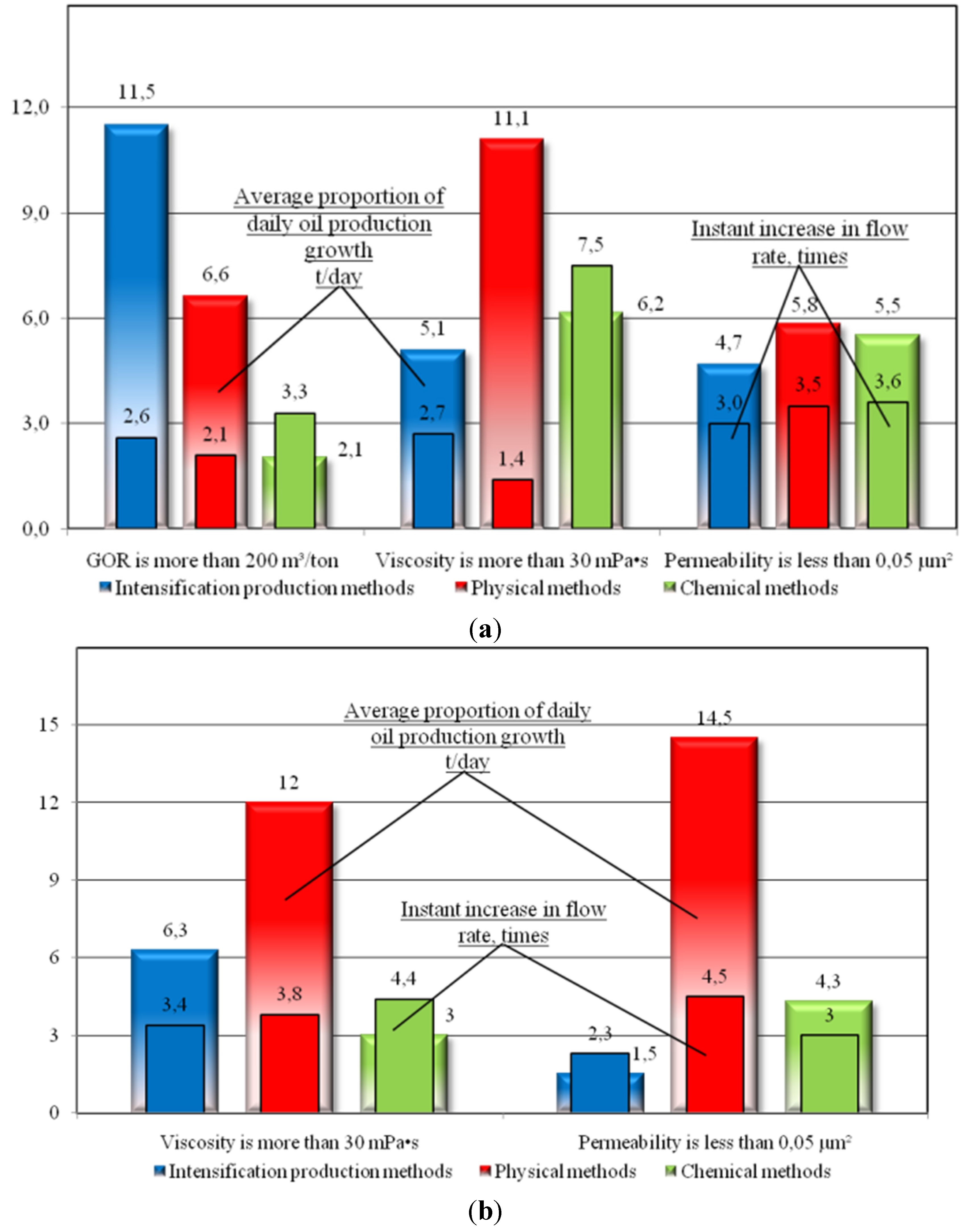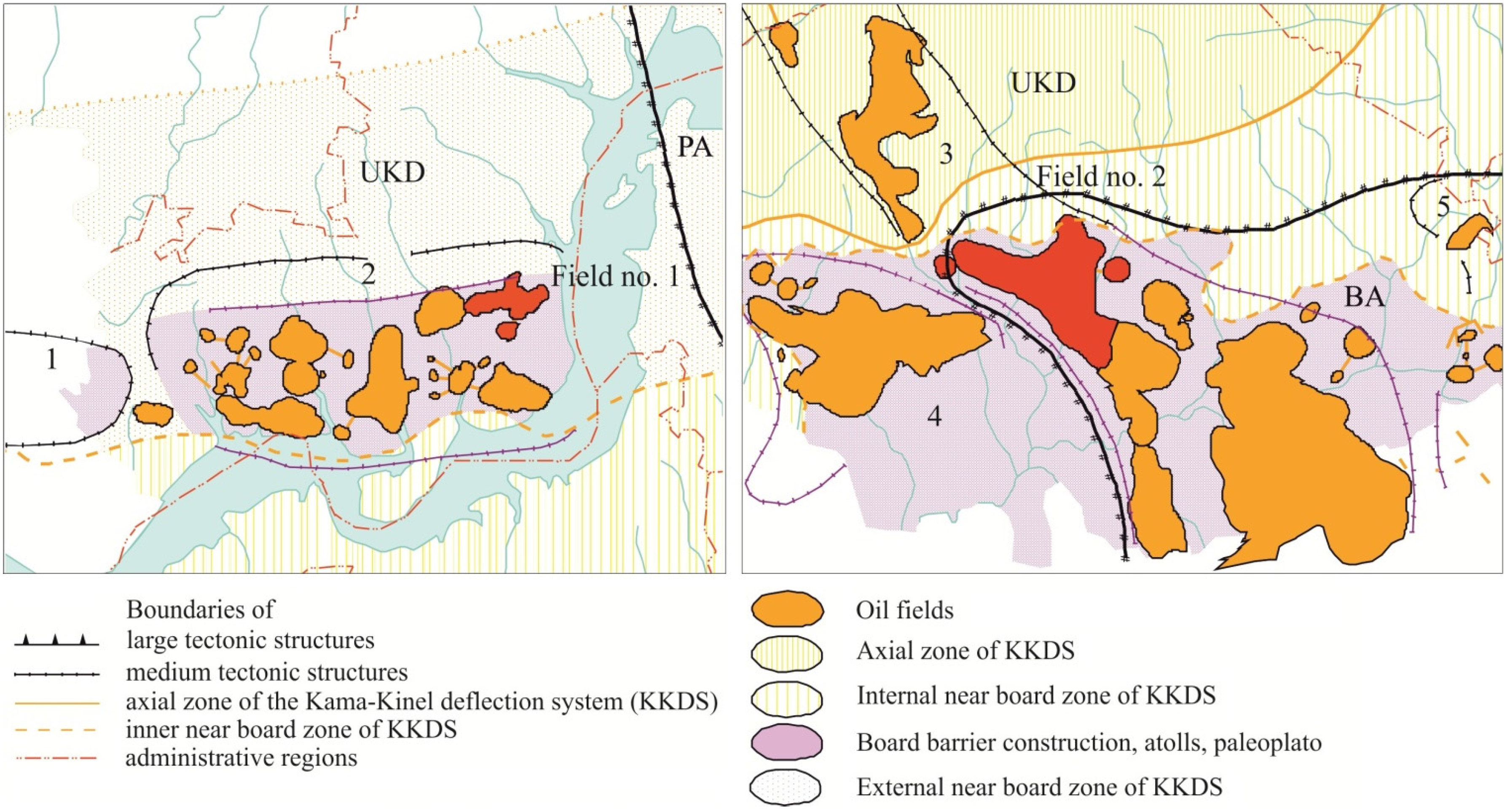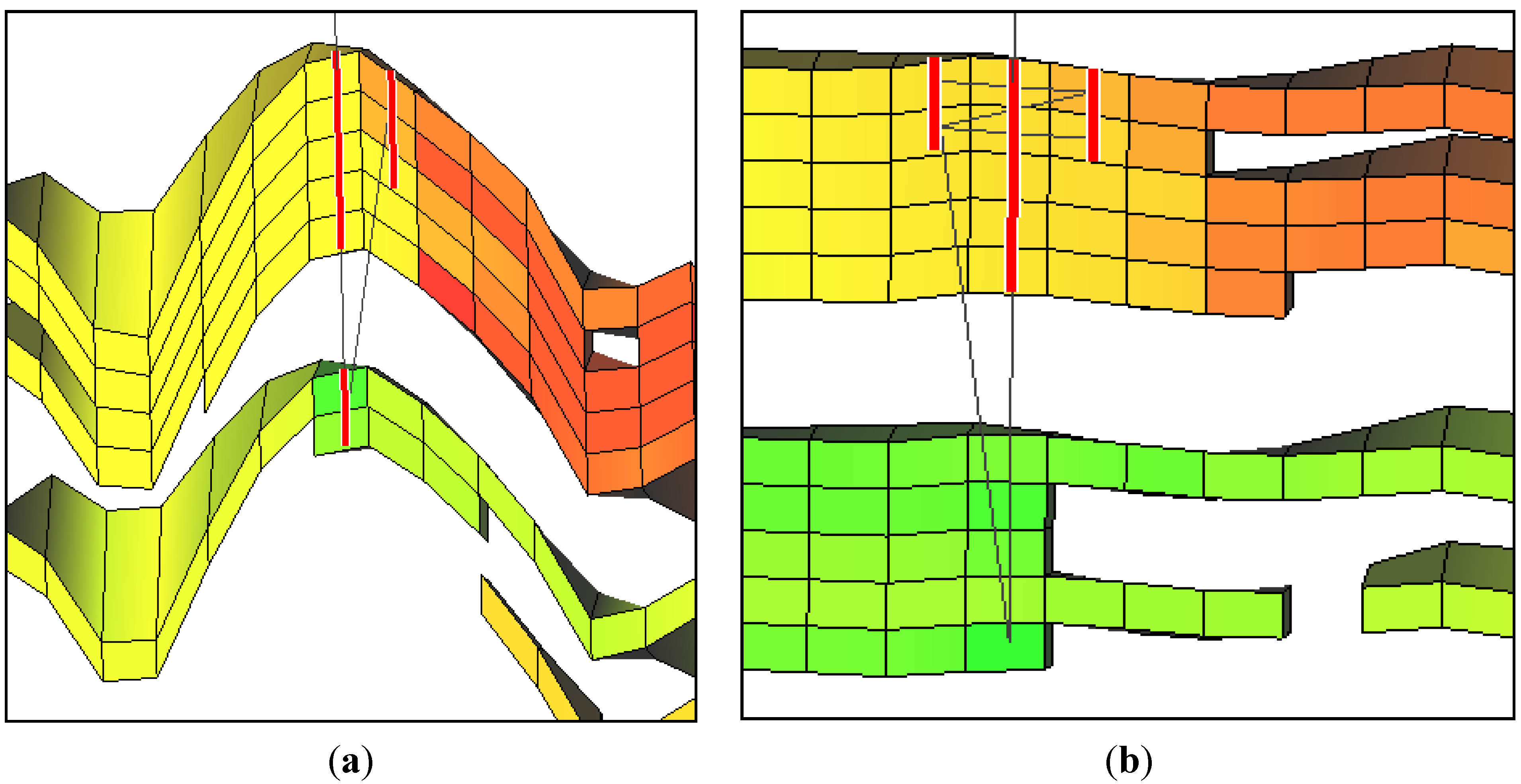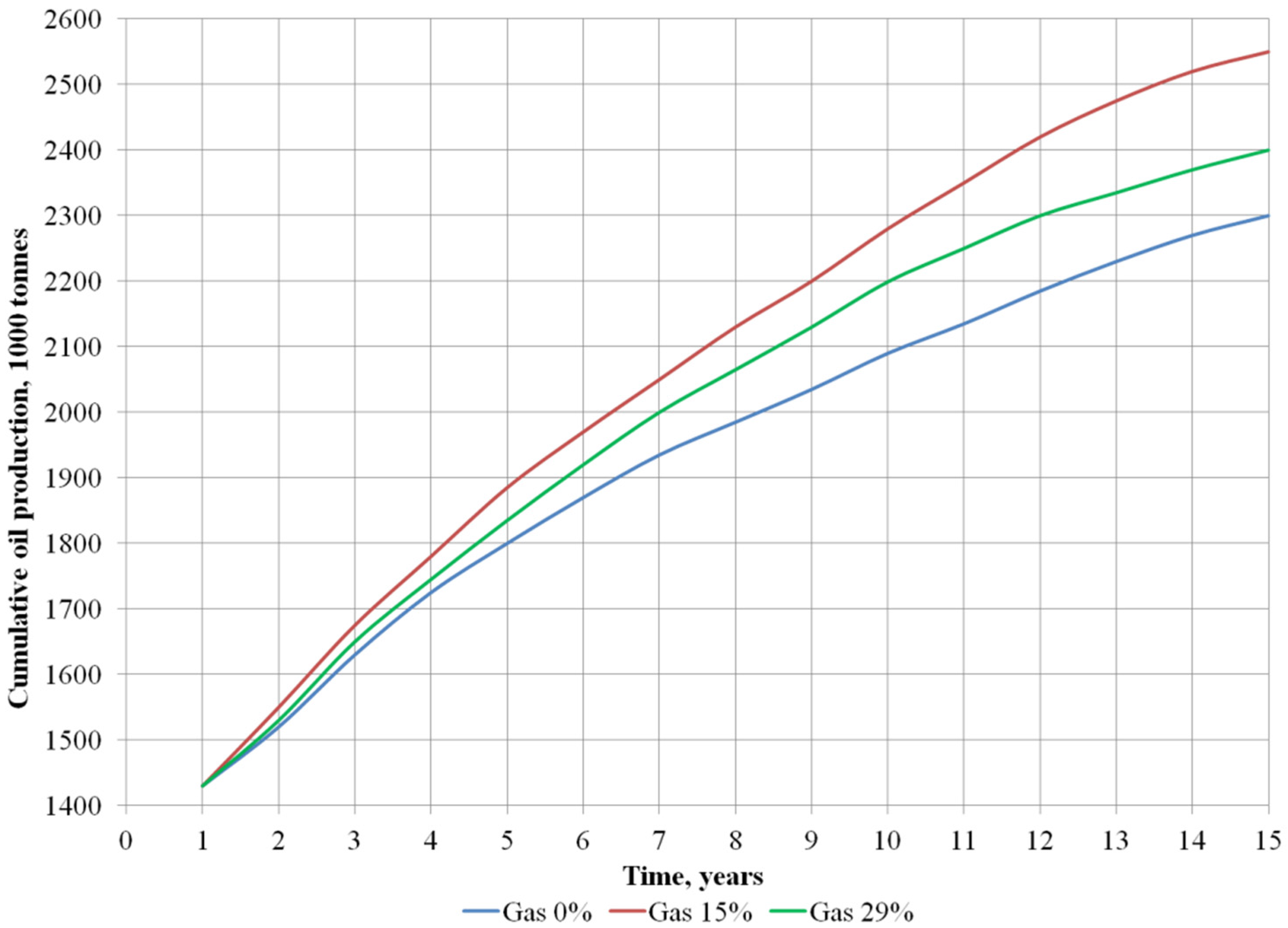Determination of Enhanced Oil Recovery Candidate Fields in the Volga-Ural Oil and Gas Region Territory
Abstract
:1. Introduction
| Production Technology | Description | Oil Recovery Factor, % | Application Features | Fields |
|---|---|---|---|---|
| CHOPS (Cold Heavy Oil Production with Sand) | Production of oil with sand by breaking weakly cemented collector and creating appropriate conditions for the movement of the oil and sand mixture in the formation [11] | up to 15 | Not applicable for production of bitumen and on the fields with bottom water | Karajanbas, Lindbergh, Bodo, Duri |
| VAPEX (Vapor Extraction Process) | It involves the use of two horizontal wells. The injection of solvent into the upper well establishes the camera-solvent. Oil is diluted by diffusion and flows along the boundaries of the chamber to a producing well under the influence of gravitational forces | up to 60 | Low energy costs, uncertainty in costs | Cold Lake, Peace River, Athabasca |
| Quarry development | Bitumen saturated rock is extracted by open method | up to 85 | Reservoir depth is up to 50 m, after extracting rocks require additional work to obtain it from the hydrocarbons, capital and operating costs are low | Bemolanga, Syukeyevskoye, Spiridonovskoye, Vassilyevskoye, Fikov-Kolokskoye |
| Cleaning mine development | The rise of hydrocarbon saturated rock on the surface | up to 45 | Reservoir depth is up to 200 m, a large amount of waste rock drivage is cost-effective only in case of the rare metals presence | Athabasca, Sunnyside, Tar Sand Triangle, PR Spring |
| SAGD (Steam-Assisted Gravity Drainage) [12] | Two closely-spaced horizontal wells, one above the other, form a steam-injector and producer pair. The reservoir oil is heated by the injected steam and drains to the producer under the effect of gravity | up to 60 | Minimum heat loss, large energy expenditures [13] | Ashalchinskoye, Athabasca, Cold Lake, Asphalt Ridge |
| Thermal mining method | The reservoir warmed up to 60–80 °C. The production is made by wells drilled from the mine workings located at the bottom of the oil-saturated reservoir. Oil is pumped to the surface after preliminary separation of mechanical impurities and water | up to 50 | Reservoir depth is up to 800 m | Yaregskoye, Lloydminster, Mordovo-Karmolskoye |
| Mine-well development | Drivage in rocks above the productive reservoir and vertical and deviated well pads are drilled into the reservoir for the oil accumulation in drivages | up to 10 | Reservoir depth is up to 400 m, it requires a huge drivage through rocks that do not contain oil | Yaregskoye, Ashalchinskoye, Circle Cliffs |
2. Results and Discussion
2.1. Analysis of the Methods that Increase Field Development Efficiency on the Volga-Ural Oil and Gas Region

| Average Additional Oil Rate, t/day | |||
|---|---|---|---|
| Sidetrack | Hydraulic Fracturing | Acid hydraulic Fracturing | Average |
| 11.8 | 13.1 | 10.9 | 11.2 |
2.2. Classification of Well-Candidates for the Use of Enhanced Oil Recovery Methods
| No. | Parameter | Group I | Group II | Group III | ||
|---|---|---|---|---|---|---|
| 1 | Oil production (t/day) | 3.58–12.02 * | 0–2.31 | 1.13–9.64 | 0.65–1.16 | 0–3.21 |
| 6.31 | 2.15 | 4.03 | 0.92 | 2.12 | ||
| 2 | Watercut (%) | 12.1–25.7 | 0–36.1 | 9.4–31.1 | 35–49.4 | 0–34.1 |
| 18.3 | 26.4 | 16.7 | 42.2 | 22.8 | ||
| 3 | Net pay thickness (m) | 3.1–5.1 | 4.4–9.3 | 3.8–6.1 | 3.1–4.4 | 2.2–6.2 |
| 4.3 | 6.0 | 5.1 | 3.7 | 3.9 | ||
| 4 | Reservoir pressure (MPa) | 8.3–9.8 | 10.8–12.6 | 8.1–9.9 | 9.7–10.3 | 8.9–14.5 |
| 8.9 | 11.8 | 9.1 | 10.0 | 11.0 | ||
| 5 | Permeability (µm2) | 0.045–0.278 | 0.011–0.042 | 0.018–0.072 | 0.001–0.003 | 0.002–0.060 |
| 0.131 | 0.020 | 0.041 | 0.002 | 0.006 | ||

3. Experimental Section
3.1. Geological and Physical Conditions of Enhanced Oil Recovery Methods Modeling

| No. | Parameter | Field No. 1 | Field No. 2 |
|---|---|---|---|
| 1 | The average depth of the roof (m) | 933 | 1613 |
| 2 | Average reservoir thickness (m) | 4.2 | 6 |
| 3 | Porosity, etc. units | 0.162 | 0.132 |
| 4 | Permeability (µm2) | 0.123 | 0.0515 |
| 5 | Net-To-Gross ratio, fr.units | 0.27 | 0.389 |
| 6 | Coefficient of compartmentalization, fr.units | 4.3 | 8.28 |
| 7 | Initial reservoir pressure (MPa) | 10.5 | 16.9 |
| 8 | Oil viscosity at reservoir conditions (mPa·s) | 6.38 | 48.8 |
| 9 | Oil density at reservoir conditions (t/m3) | 0.852 | 0.914 |
| 10 | Oil density at surface conditions (t/m3) | 0.869 | 0.915 |
| 11 | The altitude of oil-water contact (m) | −853 | −1422 |
| 12 | Oil Saturation pressure (MPa) | 8.35 | 9.9 |
| 13 | Gas content (m3/t) | 29.6 | 8 |
| 14 | Average total thickness (m) | 15.8 | 25 |
| 15 | Oil formation volume factor, share | 1.067 | 1.011 |
| 16 | Water viscosity at reservoir conditions (mPa·s) | 1.57 | 1.51 |
3.2. Field Number 1
| Well No. | Flow Rate (t/day) | Water Cut (%) | Reservoir Pressure (MPa) | Permeability (µm2) | |
|---|---|---|---|---|---|
| Oil | Liquid | ||||
| 1 | 3.9 | 4.7 | 17 | 8.7 | 0.1400 |
| 2 | 3.6 | 4.2 | 14.5 | 8.6 | 0.0746 |
| 3 | 8.2 | 9.0 | 8.8 | 8.8 | 0.0746 |
| Average value | 5.2 | 6.0 | 13.4 | 8.7 | 0.2892 |

| No. of Well | 1 | 2 | 3 | Average Value | |
|---|---|---|---|---|---|
| Method | |||||
| Radial drilling | 4952 | 3927 | 3699 | 4193 | |
| Acid treatment | 2867 | 1925 | 2274 | 2355 | |
3.3. Field Number 2
| No. | Parameters | Added Amounts of Gas (vol%) | ||||
|---|---|---|---|---|---|---|
| 0 | 6 | 12 | 25 | 30 | ||
| 1 | Density, kg/m3 | 917 | 912 | 908 | 903 | 902 |
| 2 | Viscosity, mPa∙s | 54.02 | 42.0 | 33.7 | 28.3 | 28.0 |
| 3 | Gas content, m3/m3 | 13.5 | 19.3 | 24.6 | 27.3 | 27.5 |
| 4 | Volume factor, the proportion of units | 1.031 | 1.072 | 1.098 | 1.109 | 1.111 |

4. Conclusions
Acknowledgments
Author Contributions
Conflicts of Interest
References
- Ministry of Natural Resources and Environment of the Russian Federation. Available online: http://www.mnr.gov.ru (accessed on 26 March 2014).
- Ministry of Energy of the Russian Federation. Available online: http://minenergo.gov.ru (accessed on 17 January 2014).
- Shelepov, V.V. New Enhanced Oil Recovery Technologies in Design Documents of the Central Reserves Commission, Federal Agency for Subsoil Use (Rosnedra). Drill. Oil 2011, 11, 8–12. [Google Scholar]
- Mishchenko, I.T.; Bravicheva, T.B.; Bravichev, K.A. Increasing of Development Effectiveness of Non-Uniform Reservoir Rocks at Non-Stationary Water Flooding. Drill. Oil 2009, 10, 28–30. [Google Scholar]
- Driatskaya, Z.V.; Mhchiyan, M.A.; Zhmihova, N.M. Oil in the USSR; A Directory in 4 Volumes; Publishing House “Chemistry”: Moscow, Russia, 1972. [Google Scholar]
- Rogachev, M.K. New Chemicals and Compounds of Process Fluids for Oil Extraction; Production and Practical Publication, Gilem Public: Ufa, Russia, 1999. [Google Scholar]
- Evdokimov, A.M.; Taipova, V.A.; Karpova, O.M.; Bakirov, I.M. Dual Completion Technologies Used by TATNEFT to Develop Hard-to-Recover Reserves Field Promising Results. Oil Ind. 2010, 3, 89–91. [Google Scholar]
- Chen, C.; Raghavan, R. On Some Characteristic Features of Fractured-Horizontal Wells and Conclusions Drawn Thereof (SPE-163104-PA). SPE Reserv. Eval. Eng. 2013, 16, 19–28. [Google Scholar] [CrossRef]
- Manrique, E. Enhanced Oil Recovery (EOR): Trends, Risks, and Rewards. In Proceedings of the ACI Optimising EOR Strategy, London, UK, 11–12 March 2009.
- Manrique, E.J.; Muci, V.E.; Gurfinkel, M.E. EOR Field Experiences in Carbonate Reservoirs in the United States. SPE Reserv. Eval. Eng. 2007, 10, 667–686. [Google Scholar] [CrossRef]
- Gates Ian, D.; Larter Stephen, R. Energy efficiency and emissions intensity of SAGD. Fuel 2014, 115, 706–713. [Google Scholar] [CrossRef]
- Giacchetta, G.; Leporini, M.; Marchetti, B. Economic and environmental analysis of a Steam Assisted Gravity Drainage (SAGD) facility for oil recovery from Canadian oil sands. Appl. Energy 2015, 142, 1–9. [Google Scholar] [CrossRef]
- Unconventional Oil & Gas Production. Available online: http://www.iea-etsap.org/web/ETechDS/PDF/P02-Uncon%20oil&gas-GS-gct.pdf (accessed on 15 May 2015).
- Stopa, J.; Zawisza, L.; Wojnarowski, P.; Rychlicki, S. Near-termstorage for Geological Carbon Sequestration and Storage in Poland. Gospod. Surowcami Miner. 2009, 25, 169–186. [Google Scholar]
- Wojnarowski, P. Potential for Increasing Oil Recovery from Polish Oil-Fields by Applying EOR Methods. In Mineral Resources Management; The Mineral and Energy Economy Research Institute of the Polish Academy of Sciences: Kraków, Poland, 2012; Volume 28, pp. 47–58. [Google Scholar]
- Yousef, A.A.; Al-Saleh, S.H.; Al-Kaabi, A.; Al-Jawfi, M.S. Laboratory Investigation of the Impact of Injection-Water Salinity and Ionic Content on Oil Recovery From Carbonate Reservoirs (SPE-137634-PA). SPE Reserv. Eval. Eng. 2011, 14, 578–593. [Google Scholar] [CrossRef]
- Button, P.; Peterson, C. Enhanced Gravity Drainage through Immiscible CO2 Injection in the Yates Field (TX). In Proceedings of the 10th Annual CO2 Flooding Conference, Midland, TX, USA, 8 December 2004.
- Shcherbakov, A.A.; Turbakov, M.S.; Dvoretskas, R.V. Effectiveness Analysis of Enhanced Oil Recovery of Hard-to-Recover Oil Reserves of Perm Kama Region. Oil Ind. 2012, 12, 97–99. [Google Scholar]
- Kokorev, V.I. The Innovative Approach to Development of Fields with Hard-to-Recover Oil Reserves. Oil Ind. 2009, 8, 58–59. [Google Scholar]
- Mulyak, V.V.; Chertenkov, M.V.; Shamsuarov, A.A.; Potryasov, A.A.; Shkandratov, V.V.; Shalamova, V.I.; Vakhrushev, V.V.; Sartakovet, A.M. Increasing Efficiency of Hard-to-Recover Reserves Involving in the Development with Use of Multi-Zone Hydraulic Fracturings in Horizontal Wells. Oil Ind. 2011, 11, 48–51. [Google Scholar]
- Galkin, S.V.; Ilyushin, P.Y.U.; Turbakov, M.S.; Ilyushina, K.S. Influence of Current Fund of Producing Wells while Predicting Dynamics of Water-Flooding of High-Viscous Oil Deposits. Oilfield Eng. 2012, 12, 8–11. [Google Scholar]
- Ilyushin, P.Y.; Turbakov, M.S.; Galkin, S.V. Impact Leaching on the Multiplicity of the Oil Recovery Factor for the Field of Perm Kama Region. Oil Ind. 2012, 12, 92–93. [Google Scholar]
- Erofeev, A.A.; Ponomarjova, I.N.; Turbakov, M.S. Limiting Conditions Evaluation for Processing Methods of Pressure Recovery Curves for Wells in Carbonate Collectors. Pet. Eng. 2011, 3, 12–15. [Google Scholar]
- Radaev, A.V.; Batrakov, N.R.; Kondratyev, I.A.; Mukhamadiev, A.A.; Sabirzyanov, A.N. Supercritical CO2 Displacement of High-Viscosity Oil in a Wide Range of Thermobaric Conditions. Oil Ind. 2010, 8, 110–111. [Google Scholar]
- Lisovskiy, N.N.; Khalimov, E.M. Some Words about the Classification of Unconventional Oil Reserves. Vestnik Cent. Res. Comm. Fed. Agency Subsoil Use (Rosnedra) 2009, 6, 33–35. [Google Scholar]
- Al-Taq, A.A.; Nasr-El-Din, H.A.; Beresky, J.K.; Naimi, K.M.; Sierra, L.; Eoff, L. Simultaneous Acid Diversion and Water Control in Carbonate Reservoirs: A Case History from Saudi Arabia (SPE-106951). SPE Reserv. Eval. Eng. 2008, 11, 882–891. [Google Scholar] [CrossRef]
- Schneider, C.; Shi, W.A. Miscible WAG Project Using Horizontal Wells in a Mature Offshore Carbonate Middle East Reservoir (SPE-93606). In Proceedings of the SPE Middle East Oil and Gas Show and Conference, Sanabis, Kingdom of Bahrain, 12–15 March 2005.
- Nadeson, G.; Anua, N.A.B.; Singhal, A.; Ibrahim, R.B. Water-Alternating-Gas (WAG) Pilot Implementation, A First EOR Development Project in Dulang Field, Offshore Peninsular Malaysia (SPE-88499). In Proceedings of the SPE Asia Pacific Oil and Gas Conference and Exhibition, Perth, Australia, 18–20 October 2004.
- Jayasekera, A.J.; Goodyear, S.G. Improved Hydrocarbon Recovery in the United Kingdom Continental Shelf: Past, Present and Future (SPE-75171). In Proceeding of the SPE/DOE Improved Oil Recovery Symposium, Tulsa, OK, USA, 13–17 April 2002.
- Azizi, E.; Cinar, Y. Approximate Analytical Solutions for CO2 Injectivity into Saline Formations (SPE-165575-PA). SPE Reserv. Eval. Eng. 2013, 16, 123–133. [Google Scholar] [CrossRef]
- Algharaib, M.K.; Gharbi, R.B.; Malallah, A.; Al-Ghanim, W. Parametric Investigations of a Modified SWAG Injection Technique (SPE-105071-MS). In Proceeding of the SPE Middle East Oil and Gas Show and Conference, Sanabis, Kingdom of Bahrain, 11–14 March 2007.
- Ilyushin, P.Y.; Turbakov, M.S.; Galkin, S.V. Simulation of the Water-Alternated-Gas Injection for Zmeevskoye Oil Field Development. Oil Ind. 2012, 11, 116–117. [Google Scholar]
- Filatov, M.A.; Vishnjakov, A.U.; Turbakov, M.S.; Ilyushin, P.Y. Simulation of Polymer Flooding in the Moskudinskoe Oil Field. Oil Ind. 2013, 8, 93–95. [Google Scholar]
- Petrakov, A.M. Scientific and Methodological Basis for the Use Technology of Address Impacts to Increasing the Efficiency of Stranded Oil Development (for Example, Fields in Western Siberia). Ph.D. Technical Sciences Thesis, Moscow, Russia, 2010. [Google Scholar]
- Klepatskiy, A.R. Calculation of WAG on the Experimental Plot of Moskudinskoe Field; Report of JSC; JSC “Tsentralʼnaya Geofizicheskaya Ekspeditsiya”: Moscow, Russia, 2006. [Google Scholar]
© 2015 by the authors; licensee MDPI, Basel, Switzerland. This article is an open access article distributed under the terms and conditions of the Creative Commons Attribution license (http://creativecommons.org/licenses/by/4.0/).
Share and Cite
Turbakov, M.; Shcherbakov, А. Determination of Enhanced Oil Recovery Candidate Fields in the Volga-Ural Oil and Gas Region Territory. Energies 2015, 8, 11153-11166. https://doi.org/10.3390/en81011153
Turbakov M, Shcherbakov А. Determination of Enhanced Oil Recovery Candidate Fields in the Volga-Ural Oil and Gas Region Territory. Energies. 2015; 8(10):11153-11166. https://doi.org/10.3390/en81011153
Chicago/Turabian StyleTurbakov, Mikhail, and Аleksandr Shcherbakov. 2015. "Determination of Enhanced Oil Recovery Candidate Fields in the Volga-Ural Oil and Gas Region Territory" Energies 8, no. 10: 11153-11166. https://doi.org/10.3390/en81011153






